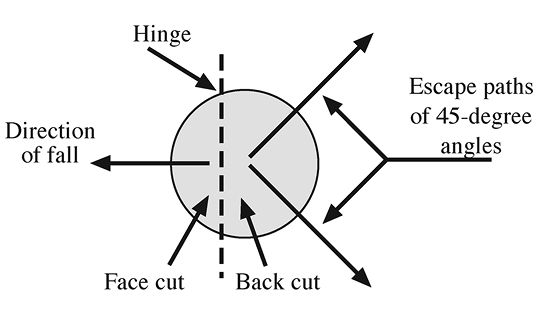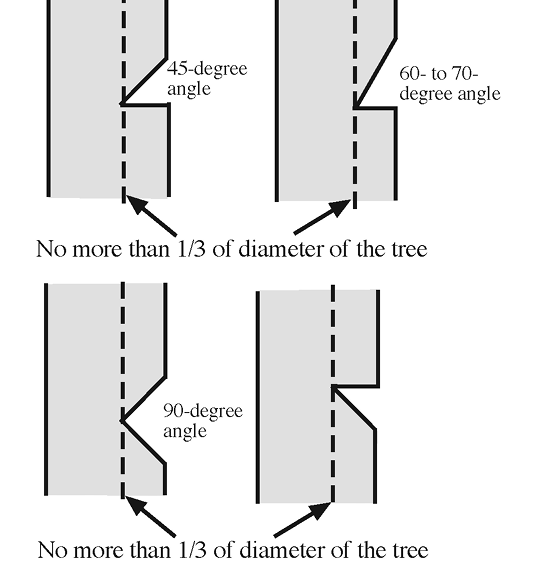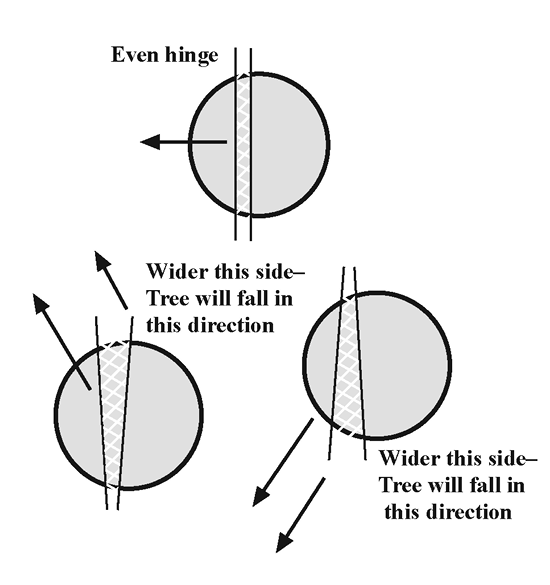Chain Saw Safety: Tree Felling
NOTE: Before using any chainsaw, carefully and thoroughly read the manufacturer’s operating and safety instructions in the owner’s manual.
Care of your forestland includes removing dead or dying trees that limit the growth of your stand. Interest in forest health has increased use of chainsaws and other mechanical equipment. For do-it-yourselfers, a chainsaw can be a major asset, but it also is one of the most dangerous tools a person can buy. Chainsaws are like computers and can do only what you tell them—the thinking is up to you.
Where Do I Start?
First, carry chainsaws with the engine stopped, guide bar and cutting chain to the rear, and muffler away from your body. When transporting your chainsaw, always use the appropriate guide bar scabbard. Remember, the chainsaw is a tool. As with any tool, the cleaner, sharper, and more efficient it is, the better it will perform. Learn the basic maintenance points on your chainsaw, and be careful to follow the manufacturer’s sharpening and maintenance instructions.
Your owner’s guide outlines proper chain tension, gas mixture, oil weight, and other specifications. Leave all chainsaw service, other than items mentioned in the owner’s maintenance manual, to a skilled chainsaw service provider. Most dealers will be happy to work with you on maintenance techniques and frequency of service.
Basic Chainsaw Safety
Logging is one of the nation’s most hazardous occupations, and the chainsaw, in large part, is responsible for this danger. Use a chainsaw only if you feel comfortable with your experience and ability to handle one. Follow these basic safety tips to lessen the risk of chainsaw injuries:
- Read and understand the safety operations manual provided with your saw.
- Always wear appropriate safety equipment and clothing.
- Never cut alone.
- Be aware of others in your immediate working area. Keep children and pets at a safe distance.
- Do not operate the saw when you are tired. Fatigue is your enemy. Rest helps you stay alert with a strong sense of balance, footing, and saw grip.
- Do not use a chainsaw if you have been drinking alcoholic beverages or if you are taking prescription medication or nonprescription drugs.
- Do not overreach or cut above shoulder height. It is difficult to control the saw in awkward positions.
- Do not operate a chainsaw in a tree or from a ladder unless you have been specifically trained and are equipped to do so.
- Keep the chain moderately tight and sharp. A dull chain saps your strength and shortens the life of the bar and engine.
- Refuel after letting the saw cool for about 10 minutes. This is also a good time to sharpen the chain.
- Be careful when handling fuel. Move the chainsaw at least 10 feet away from the fueling point before starting the engine. Do not smoke while refueling your saw.
These rules and guidelines may not prevent injury, but they might help reduce the severity of an injury.
Why Wear Safety Gear?
Safety equipment and clothing are designed to protect you from tree material, cutting effects of the saw, and other dangers of chainsaw use. Hazards include the following possibilities:
- Hearing loss from too much saw noise.
- Eye injury from flying objects such as sawdust and debris.
- Head injuries from falling limbs or tree debris.
- Cuts to legs, feet, hands, arms, and shoulders.
The U.S. Department of Labor, through its Occupational Safety and Health Administration (OSHA), designed a set of regulations professional loggers must follow for chainsaw use. These regulations were developed in response to common injuries associated with the logging industry. The American National Standards Institute (ANSI) certifies safety equipment to ensure the maximum protection available for a specific danger. Any safety equipment you purchase must meet the following minimum ANSI standards:
- Earplugs or earmuffs protect your hearing. Look for the ANSI/ASA S12.6-2016 (R2020) code to ensure the device reduces noise by at least 20 decibels. A chainsaw produces about 110 decibels and damages your hearing after prolonged use.
- Eye protection is available in three forms: full-face screens, goggles, and safety glasses. Make sure the type you buy conforms to ANSI standard Z87.1-2003. This code is marked somewhere on the device or the package. Eye protection needs to be comfortable and held firmly in place. Also wear safety glasses or goggles under a full-face shield.
- Protect your legs with chaps (or trousers) made of ballistic nylon fibers that, when cut, clog the chainsaw and stop it from cutting. These leg-safety devices must meet ASTM F1414-19 to be effective at reducing cutting injuries.
- Wear a good, comfortable steel-toed boot for all cutting. ASTM F1458-04 tests boots against cutting and crushing accidents.
- A hard hat is the most overlooked piece of in-woods safety equipment. Hard hats that meet ANSI Z89.1-1986 standards protect against falling tree parts and flying objects. A hard hat with earmuffs and a face shield is best for all saw work. These hats meet all ANSI standards and are fairly inexpensive.
- Gloves protect hands and ensure a better grip on the chainsaw. Because the hand is the part of the body most in contact with the saw, gloves are essential for safe saw use.
Are You Ready to Cut Trees?
No! You need to answer a few questions before starting to fell a tree.
- Do you have all the required safety clothing? Safety gear is a staple for most professional loggers, foresters, fire crews, and other forest-related professionals. Make it a staple for you, too.
- Do you feel comfortable cutting trees yourself? Any time you feel uncomfortable cutting, don’t! It is too dangerous to take chances.
- Can your chainsaw cut this tree? Is the bar too short to cut completely through the tree? Cutting a tree that is larger than the bar requires skill and is not addressed in this publication. Have a professional show you how it’s done.
- Is this tree next to a power line or a house? Never cut a tree next to a power line or house; leave this job to a professional.
- Is it too windy to cut safely? Is it too wet? Weather plays an important role in safe cutting. Wind can push a tree in unexpected directions, and rain can make conditions too slippery to cut safely.
What Is Kickback?
Kickback describes what happens to the chainsaw when the tip of the bar contacts an object while the chain is moving. A single sawtooth essentially jams into an object, and, instead of cutting it, the energy from the saw is redirected back and up. This causes the saw to jump (kick back) in your hands and can cause severe injury.
To help avoid kickback, make sure the area where you are cutting has no obstructions. Do not let the nose of the guide bar contact a log, branch, rock, or any other obstruction while you are operating the saw. Do not cut near fences or in areas where there is loose or scrap wire.
Most new chainsaws have an “inertial” chain brake. If the chainsaw gets pushed back at a certain speed, the brake is engaged, automatically bypassing the mechanical brake.
Felling
Felling trees safely requires two steps. Each tree you cut presents a unique set of hazards and complications. Using the chainsaw is the second step in cutting down a tree. Follow these steps, and it will soon become second nature.
Step 1: Assess the situation.
Look around before you start cutting down a tree. Where is the tree? Does it lean? Can you drop it where you want? Where are your escape routes? It seems like a lot to think about, but with practice it will become second nature each time you use a chainsaw.
The easiest way to determine if the tree is leaning is to use an axe as a plumb line. Hold the axe out by the end of the handle at arm’s length. Compare it to the tree at multiple points around the trunk. If the tree is out of line, it leans. Also check to see if one side has more branches. Extra weight on one side pulls the tree in that direction. Accurately assessing the lean of a tree takes practice.
As you assess the tree for lean and weighting, check for large loose limbs hanging from the tree. Some may be obvious, while others are not. Have your felling partner keep an eye on the tree as you complete the next few tasks.
After you have determined the lean and weighting of the tree, you can determine the direction you want it to fall. When possible, fell the tree with the lean to make cutting easier. It is possible to fell a tree away from the direction of lean, but it requires considerable experience. (Advanced cutting techniques are not included in this publication.) Make sure the tree has a clear path to fall. Clear out around the base of the tree to provide solid footing and an unobstructed view of your work. Clear two escape paths that lead in the opposite direction of the anticipated fall of the tree (Figure 1).

Step 2: Use the Chainsaw
Safely felling a tree requires at least two different cuts, the face cut and the back cut. The face cut is a wedge (typically cut at 45 to 90 degrees) removed from the tree, facing the direction of fall (Figure 2). There are numerous ways to cut this wedge, but concentrate on the basic 60- to 70-degree face cut with a flat bottom.

Make the back cut behind the wedge cut. Align your saw even with or 1 or 2 inches above the base of the notch. Make sure you cut parallel to the notch. Cut quickly and smoothly while watching the cut and the tree. Do not cut all the way through the tree. You need to leave between one-half inch to 1 inch of wood between the back cut and the notch. This is called the hinge, and it controls the direction and rate of fall (Figure 3).

As soon as the tree begins to fall, remove the saw, turn it off, turn, and proceed quickly (do not run) along one of your escape paths (away from the direction of the fall). You need to clear the area quickly so, if something goes wrong, you won’t be injured. The tree can kick back off the stump, catch and roll toward you, or have other unexpected reactions. After you hear the tree hit the ground, it is safe to turn and inspect the tree.
At this point, you have safely felled a tree. Felling is difficult to master, but it is an extremely satisfying job. Remember, always work safely, buy and wear all the appropriate safety equipment, know your limitations, and never cut alone. Felling a tree is not worth getting injured or killed. Above all else, leave the professional logging jobs to professional loggers.
The information given here is for educational purposes only. References to commercial products, trade names, or suppliers are made with the understanding that no endorsement is implied and that no discrimination against other products or suppliers is intended.
Publication 2250 (POD-10-22)
Revised by Brady Self, PhD, Associate Extension Professor, Forestry, from and earlier version by John B. Auel, PhD, Assistant Extension Professor, Forestry (retired).
The Mississippi State University Extension Service is working to ensure all web content is accessible to all users. If you need assistance accessing any of our content, please email the webteam or call 662-325-2262.





